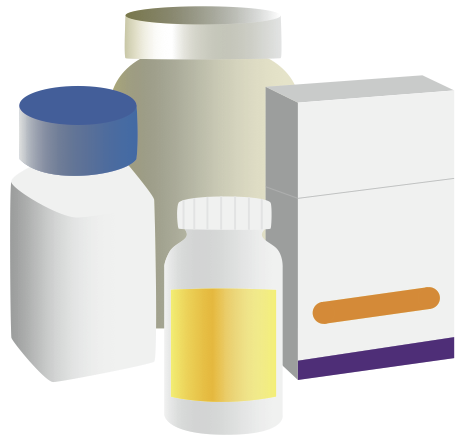Cholesterol Medications
 The following article provides information on the major classes of cholesterol medications, including statins, selective cholesterol uptake inhibitors, cholesterol binding resins, fibric acid derivatives, and nicotinic acid.
The following article provides information on the major classes of cholesterol medications, including statins, selective cholesterol uptake inhibitors, cholesterol binding resins, fibric acid derivatives, and nicotinic acid.
- Statins (HMG CoA Reductase Inhibitors): Statins are the first line cholesterol medications for treating elevated cholesterol levels. They have the greatest efficacy in lowering LDL cholesterol and are well tolerated. Additionally, multiple trials have shown that reducing LDL cholesterol levels with statins reduces illness and death from cardiovascular disease.
The major potential side effect of statins is generalized muscle pain, which may require changing to a different statin or avoiding the drug class all together. Patients on statins may also require periodic blood tests to monitor their liver functions.
The interesting thing about statins is that they may actually decrease cardiovascular risk in individuals even if those individuals’ cholesterol levels are normal. For its cardio-protective effects, statins are sometimes referred to as “the new aspirin.”
Many generic and brand name statins are available on the market. Examples include Lipitor (Atorvastatin), Crestor (Rosuvastatin), and Zocor (Simvastatin) among several others.
- Selective Cholesterol Uptake Inhibitors: Ezetimibe (Zetia) is the only medication in this class. It prevents cholesterol absorption in the intestines. It can be used by itself to lower LDL cholesterol levels; however, it is particularly useful when used in combination with a statin. Vytorin is a combination of Ezetimibe and Simvastatin and allows patients to take the two medications as a single pill.
Ezetimibe does not generally cause GI upset or constipation and does not interfere with the absorption of other medications.
- Cholesterol Binding Resins (AKA Bile Acid Sequestrants): These cholesterol medications work by preventing the reabsorption of bile in the intestines, which consequently prevents cholesterol reabsorption in the intestines. They are generally used in conjunction with other medications, especially statins, and have modest LDL cholesterol lowering effects. These agents may also raise triglyceride levels.
The major side effects of this class of medications are GI upset and constipation. Additionally, these medications can prevent the absorption of other medications. Other medications should be taken at least 1 hour before or 4 hours after taking cholesterol binding resins.
Examples include Cholestyramine (Questran), Colestipol (Colestid), and Colesevelam (WelChol). Welchol is the newest medication in this class and is purported to have lower GI side effects and fewer medication interactions.
- Fibric Acid Derivatives (Fibrates): Fibrates generally lower triglyceride levels and raise HDL cholesterol levels; however, they do not lower LDL cholesterol levels. They can be used by themselves or in conjunction with other cholesterol medications.
These medications increase the risk of statin-induced muscle pain.
Examples include Gemfibrozil (Lopid) and Fenofibrate (Tricor). Bezafibrate is also available outside of the United States.
- Nicotinic Acid (Niacin): Niacin is actually a vitamin, Vitamin B-3. Niacin taken at high doses, at least 1-1.5 grams per day, can reduce LDL cholesterol and triglyceride levels while also increasing HDL cholesterol levels. Niacin also costs less than other cholesterol lowering medications. It is available in immediate release and extended release forms. Prescription forms of niacin are preferred to over the counter forms of niacin, which are generally not effective at altering cholesterol levels.
The major side effects of high-dose niacin include flushing and liver toxicity. Period blood tests to monitor liver function are required for patients on niacin.
Immediate-release prescription forms of niacin include Niacor and Nicolar. Extended-release prescription forms of niacin include Slo-Niacin and Niaspan.




